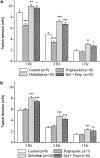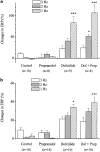Beta-adrenoceptor activation plays a role in the reverse rate-dependency of effective refractory period lengthening by dofetilide in the guinea-pig atrium, in vitro
- PMID: 12922944
- PMCID: PMC1573989
- DOI: 10.1038/sj.bjp.0705395
Beta-adrenoceptor activation plays a role in the reverse rate-dependency of effective refractory period lengthening by dofetilide in the guinea-pig atrium, in vitro
Abstract
1. Blockers of the rapid component of the delayed rectifier potassium current (I(Kr)) prolong cardiac action potential duration (APD) and effective refractory period (ERP) in a reverse rate-dependent manner. Since activation of beta-adrenoceptors attenuates prolongation of APD evoked by I(Kr) blockers, rate-dependent neuronal noradrenaline liberation in the myocardium may contribute to the reverse rate-dependent nature of the effects of I(Kr) blockers. In order to test this hypothesis, we studied the effects of dofetilide, a pure I(Kr) blocker, on ERP after activation or blockade of beta-adrenoceptors and after catecholamine depletion in guinea-pig left atrial myocardium paced at 3, 2 and 1 Hz, in vitro. 2. Dofetilide (100 nM) lengthened ERP in a reverse rate-dependent manner in the left atrial myocardium of guinea-pigs. Strong activation of beta-adrenoceptors using 10 nM isoproterenol abolished the dofetilide-induced lengthening of ERP at all pacing rates. 3. Blockade of the beta-adrenoceptors with metoprolol (1 micro M), atenolol (3 micro M) or propranolol (300 nM) increased the dofetilide-evoked prolongation of ERP at 3 and 2 Hz, but not at 1 Hz. As a consequence, metoprolol attenuated while propranolol and atenolol fully eliminated the reverse rate-dependent nature of the dofetilide-induced ERP lengthening. In catecholamine-depleted atrial preparations of the guinea-pig (24 h pretreatment with 5 mg kg(-1) reserpine i.p.), the effect of dofetilide on ERP was not frequency dependent, and propranolol did not alter the effects of dofetilide. 4. In contrast to results obtained in guinea-pig atrial preparations, propranolol failed to change the reverse rate-dependent effect of dofetilide on ERP in the right ventricular papillary muscles of rabbits and guinea-pigs. 5. As an indication of the functional consequences of rate-dependent noradrenaline liberation, propranolol decreased twitch tension at 3 and 2 Hz but not at 1 Hz in the atrial myocardium of control guinea-pigs, whereas no such effect was detected in catecholamine-depleted atrial preparations. Propranolol failed to change contractility of ventricular myocardium in guinea-pigs and rabbits. 6. It is concluded that rate-dependent noradrenaline release and the ensuing beta-adrenoceptor activation contributed to the reverse rate-dependent nature of ERP prolongation caused by I(Kr) blockers in isolated guinea-pig atrial myocardium.
Figures





Similar articles
-
Effects of dofetilide and EGIS-7229, an antiarrhythmic agent possessing class III, IV, and IB activities, on myocardial refractoriness in hyperkalemia, hypokalemia, and during beta-adrenergic activation in the rabbit papillary muscle in vitro.J Pharmacol Sci. 2006 Apr;100(4):303-9. doi: 10.1254/jphs.fp0051009. Epub 2006 Apr 7. J Pharmacol Sci. 2006. PMID: 16603803
-
Effects of EGIS-7229 (S 21407), a novel class III antiarrhythmic drug, on myocardial refractoriness to electrical stimulation in vivo and in vitro.J Cardiovasc Pharmacol. 2001 Jan;37(1):78-88. doi: 10.1097/00005344-200101000-00009. J Cardiovasc Pharmacol. 2001. PMID: 11152377
-
Electrophysiological and antiarrhythmic effects of the novel I(Kur) channel blockers, S9947 and S20951, on left vs. right pig atrium in vivo in comparison with the I(Kr) blockers dofetilide, azimilide, d,l-sotalol and ibutilide.Naunyn Schmiedebergs Arch Pharmacol. 2002 Nov;366(5):482-7. doi: 10.1007/s00210-002-0599-x. Epub 2002 Sep 5. Naunyn Schmiedebergs Arch Pharmacol. 2002. PMID: 12382079
-
KCB-328: a novel class III antiarrhythmic agent with little reverse frequency dependence in isolated guinea pig myocardium.J Cardiovasc Pharmacol. 1998 Apr;31(4):609-17. doi: 10.1097/00005344-199804000-00021. J Cardiovasc Pharmacol. 1998. PMID: 9554812
-
Atrial effects of the novel K(+)-channel-blocker AVE0118 in anesthetized pigs.Cardiovasc Res. 2003 Nov 1;60(2):298-306. doi: 10.1016/s0008-6363(03)00543-1. Cardiovasc Res. 2003. PMID: 14613859
References
-
- BASKIN E.P., LYNCH J.J. Differential atrial versus ventricular activities of class III potassium channel blockers. J. Pharmacol. Exp. Ther. 1998;285:135–142. - PubMed
-
- BERMAN N.D., DORIAN P. Cellular mechanism underlying the efficacy of the sotalol-quinidine combination. J. Cardiovasc. Pharmacol. 1993;21:609–614. - PubMed
-
- CHO H., NAM G.B., LEE S.H., EARM Y.E., HO W.K. Phosphatidylinositol 4,5-bisphosphate is acting as a signal molecule in α1-adrenergic pathway via the modulation of acetylcholine-activated K+ channels in mouse atrial myocytes. J. Biol. Chem. 2001;276:159–164. - PubMed
MeSH terms
Substances
LinkOut - more resources
Full Text Sources
Research Materials

